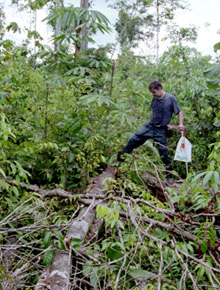Storm Killed Half Billion Amazon Trees
A single, violent storm that swept across the whole Amazon forest in 2005 killed half a billion trees, according to a new study by Tulane University researchers.

Scientist Giuliano Guimaraes, a coauthor of the study, examines a fallen tree in an area where trees were blown down by a storm in the Amazon forest near Manaus, Brazil. (Photo from Jeff Chambers)
While storms have long been recognized as a cause of Amazon tree loss, this study is the first to produce an actual body count. The losses are much greater than originally suspected, suggesting that storms may play a larger role in the dynamics of Amazon forests than previously recognized.
Amazon rain forests, which are thought to absorb a significant portion of carbon dioxide from the earth's atmosphere, are an important bellwether for climate change researchers. Tree loss in the Amazon is considered one of a number of potential “tipping points” related to issues of rapid climate change.
The new study says that a single squall line of severe thunderstorms in January 2005 had an important role in the tree demise. This type of storm might become more frequent in the future in the Amazon due to climate change, killing a higher number of trees and releasing more carbon to the atmosphere, according to the paper's Tulane authors, atmospheric scientist and postdoctoral researcher Robinson Negron-Juarez and forest ecologist Jeffrey Chambers.
The article has been accepted for publication in Geophysical Research Letters, a journal of the American Geophysical Union.
The researchers used a combination of satellite images, field-measured tree mortality and modeling to determine the number of trees killed by the storm.
“It's very important that when we collect data in the field we do forensics on tree mortality,” says Chambers, an associate professor in the ecology and evolutionary biology department who has been studying forest ecology and carbon cycling in the Amazon since 1993. “Under a changing climate, some forecasts say that storms will increase in intensity. If we start seeing increases in tree mortality, we need to be able to say what's killing the trees.”
